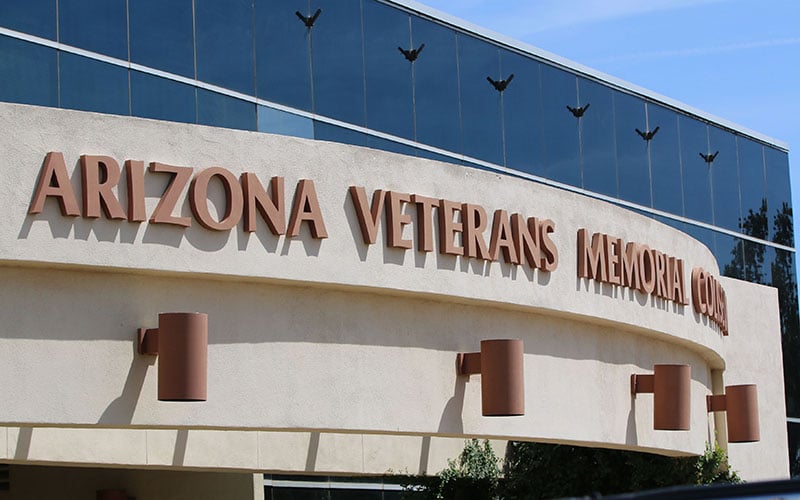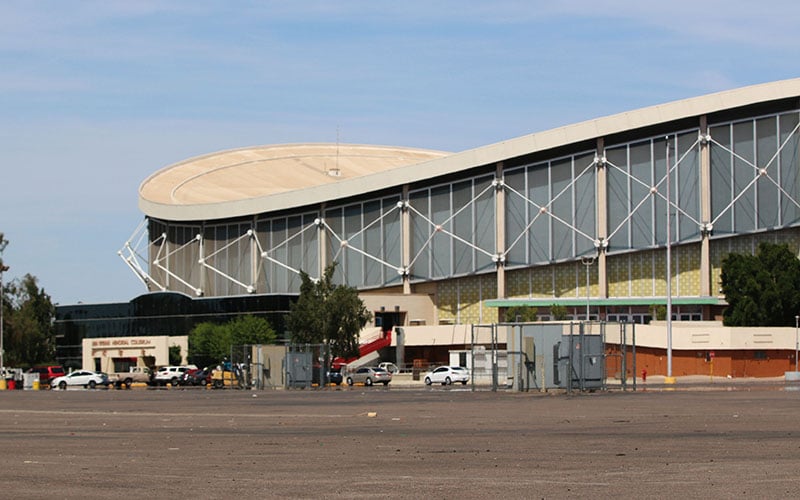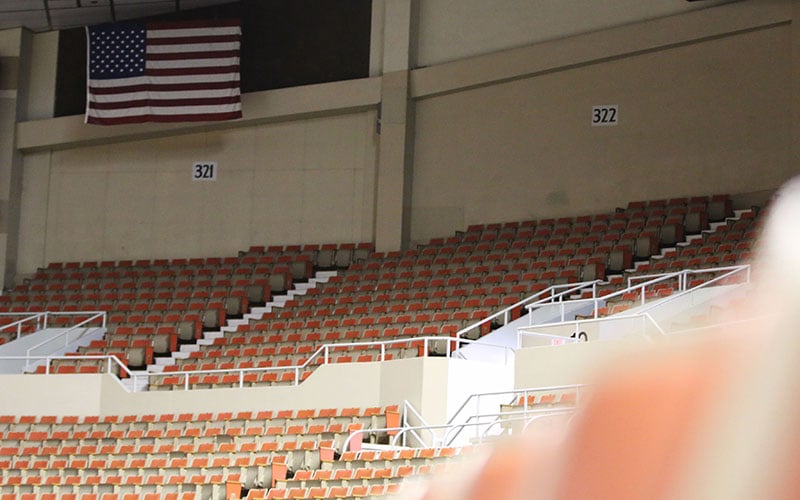
Arizona Veterans Memorial Coliseum was home to the Phoenix Suns for their first 26 years (Photo by Jake Gadon/Cronkite News)

Arizona Veterans Memorial Coliseum was opened in 1965 and reinvented itself after the Suns left. (Photo by Jake Gadon/Cronkite News)

The American flag hangs in the rafters of the Arizona Veterans Memorial Coliseum.
(Photo by Jake Gadon/Cronkite News)
Once known as “The Madhouse on McDowell” when it shook during Phoenix Suns games, Arizona Veterans Memorial Coliseum leads a quieter existence these days without a professional sports franchise.
Today, it plays host to concerts, roller derby, gun and boat shows, cheerleading competitions and other events. National and international recording artists often use the facility to stage and rehearse shows before going on tour.
Read more:
Suns, Coyotes, Diamondbacks wandering in the desert, pondering new homes
Team owners starting to demand new stadiums sooner
In limited market, Phoenix teams turn to Native American communities to sponsor arenas
Watch:
VIDEO: The D-Backs, Maricopa County and their $187-million ballpark dispute
VIDEO: Peanuts, Cracker Jacks and poutine: the new era of stadium food
Changing the business model has kept the Coliseum, which opened in 1965 to serve as the home of the Arizona State Fair, operating since the Suns departed in 1992 and the Phoenix Roadrunners minor league hockey club left in 1997. The Suns had called the Coliseum home dating to when the NBA expansion franchise began play in 1968.
“We are lucky because we have withstood the test of time,” said Jen Yee, assistant executive director of the Arizona Exposition and State Fair, which manages the property. “We adjusted . . . and we figured out how to make money in other places on these grounds.”
Officials at other venues such as Chase Field, Gila River Arena and Talking Stick Resort Arena may soon face a similar challenge if their current tenants depart for new homes.
Gila River Arena in Glendale soon could join the Coliseum as a major facility without a professional sports franchise as a tenant. The NHL Arizona Coyotes are not expected to play there beyond next season and are looking for a new home outside of the west Valley.
The Arizona Diamondbacks, in a feud with Maricopa County over stadium repairs, are exploring local sites beyond Chase Field. The Suns, also looking ahead, are concerned that their arena is now 24 years old.
“They, too, will have to figure out how to change their business model to keep the doors open,” Yee said of the other venues. “But we have already done that at the Coliseum.”
Many owners want the latest and greatest in stadium upgrades. But owners who move their teams leave a hole in the community. Trying to find a functional use for a stadium after a team has left can be difficult.
“Yes, someone will come in and take their place, but it is a very limited market,” said Neil DeMause, author of Field of Schemes: How the Great Stadium Swindle Turns Public Money into Private Profit.
Coliseum officials found an underserved niche in the marketplace by renting the facility to recording artists.
“Think about it from an artist perspective,” Yee said. “There is no place you can find a big, empty arena on the west coast because they are all slated for sports teams. And no one is willing to block out a month of time in the middle of basketball or hockey season. For us, we have easy access to L.A.”
From Elvis performing there in 1970 to Barack Obama holding a presidential rally in 2008, the Coliseum has seen it all. And every year it serves as the centerpiece of the Arizona State Fair.
“During the run of the Fair in October we will do 14 to 15 national concerts in the Coliseum during the 18 days of the Fair. So that is where we generate the most amount of revenue throughout the year,” Yee said.
The Coliseum is also not as expensive as the Valley’s other major venues to rent for events, according to Yee. This helps the Coliseum attract clients that wouldn’t be able to afford to use the other arenas, yet are satisfied with an older and more convenient facility.
“I think the competitive landscape and the economy in Arizona had a lot to do with keeping the Coliseum intact,” Yee said. “We tried to be very innovative in trying to keep our doors open — trying to do something different, go to an untapped market.
“Not to say those venues do not do that, but it is probably much harder with a 40,000-seat baseball stadium.”
The Suns played at the Coliseum for 24 years. The Diamondbacks have occupied Chase Field for 18 years. The Coyotes have called Gila River Arena home for only 13 years.
“It’s really sad because I am a native and these are beautiful venues,” Yee said. “Seeing them being built, you get really excited to see how much progress is being made. And then you hear the hockey team may be leaving Glendale, and you hear about the Diamondbacks and Chase Field. It is just sad.”
Mo Stein, Phoenix office director at HKS Architects, said stadiums in years past were designed as single-purpose buildings. Today, they have to be useful for other purposes
“Today, we are essentially designing facilities that are expected to last one generation, and are, in fact, very multi-purpose and programmed for far more than sports,” Stein said,
The design process goes beyond the building and now includes spaces that create community — hopefully even when the facility is past its prime.
“I think you consider the end of the term for any building you do, in terms of next generation, upgrades or re-use,” Stein said. “It is a bit more complex with the scale of these structures. I like to consider the planning aspects of land use and adjacency, not just the physical building.”
Meanwhile, the Coliseum is still standing, and there are no plans to change how it is used.
“Now who would want to knock down the Coliseum?” Yee asked. “It’s an icon! We may be older, but we are the most convenient option in Phoenix. And people will pay for that.”